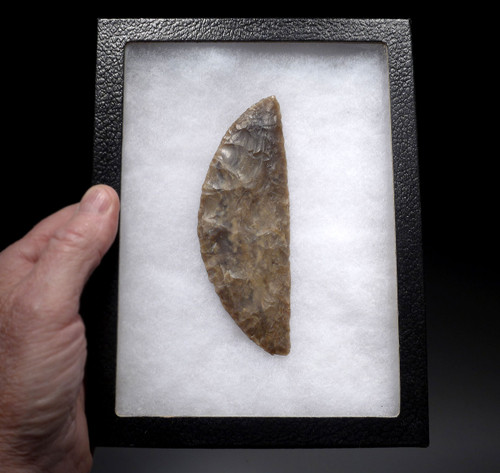Product Description
SEE MORE EUROPEAN NEOLITHIC ARTIFACTS
SEE MORE EUROPEAN BRONZE AGE ARTIFACTS
The predominant change in prehistoric life that brought about the Neolithic age, was the invention of crop farming. In the Neolithic Period, the main tool that would have been needed to harvest crops would have been a flaked flint sickle. Some sickles were single curved or lunate-shaped flint blade knives while other designs employed wooden shafts lined with flint bladelets to cut the crop stems. The specimen offered here is of the first type and is a main lunate sickle blade that would have been hafted into a wooden handle.
This incredible bifacially flaked specimen was made in the form of a classic Late Neolithic lunate blade where the straight edge was the cutting edge. It features the finest workmanship. It was found in Denmark and comes from the Corded Ware Culture. This culture ranged in time from the Late Neolithic through the Chalcolithic, and into the Early Bronze Age. This flint lunate sickle blade knife would have been affixed to a bone or wooden handle and used as a single-handed sickle for harvesting cereal crops. The cutting edge shows a glossy natural use wear polish from its extensive cutting of Emmer wheat, as the fine abrasive nature of this crop highly polished flint blades over time. The warm gray colored flint beautifully shows of the highlights of this use polish, as well as the masterful pressure flaking of the entire surface and sharpening flakes on the blade edge.
While we have offered Neolithic sickles of various types in the past, never have we had one so beautiful as this and of a perfect, tapered lunate form. Complete and intact as originally made, with ancient mineral deposits and no evidence of any alteration or modern flaking testifying to its authenticity and supreme preservation.
Following this period in time, these sickles would be replaced with copper, and then bronze examples.
HISTORY
The Corded Ware culture comprises a broad archaeological horizon of Europe between ca. 2900 BCE – 2350 BCE, thus from the late Neolithic, through the Copper Age, and ending in the early Bronze Age. The Corded Ware culture encompassed a vast area, from the contact zone between the Yamnaya culture and the Corded ware culture in south Central Europe, to the Rhine on the west and the Volga in the east, occupying parts of Northern Europe, Central Europe and Eastern Europe. The term Corded Ware culture is named after the cord-like impressions or ornamentation characteristic of its pottery.
Corded Ware encompassed most of continental northern Europe from the Rhine on the west to the Volga in the east, including most of modern-day Germany, the Netherlands, Denmark, Poland, Lithuania, Latvia, Estonia, Belarus, Czech Republic, Austria, Hungary, Slovakia, Switzerland, northwestern Romania, northern Ukraine, and the European part of Russia, as well as coastal Norway and the southern portions of Sweden and Finland. In the Late Eneolithic / Early Bronze Age, it encompassed the territory of nearly the entire Balkan Peninsula, where Corded Ware mixed with other steppe elements.
Archaeologists note that Corded Ware was not a "unified culture," as Corded Ware groups inhabiting a vast geographical area from the Rhine to Volga seem to have regionally specific subsistence strategies and economies. This culture included the Battle Axe culture and the Single Grave culture. There are differences in the material culture and in settlements and society. At the same time, they had several shared elements that are characteristic of all Corded Ware groups, such as their burial practices, pottery with "cord" decoration and unique stone-axes.
 US DOLLAR
US DOLLAR
 EURO
EURO
 AUSTRALIAN DOLLAR
AUSTRALIAN DOLLAR
 CANADIAN DOLLAR
CANADIAN DOLLAR
 POUND STERLING
POUND STERLING
























